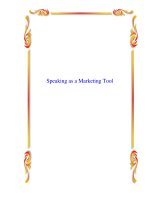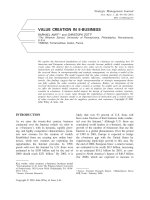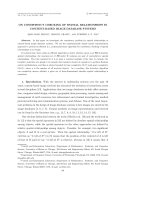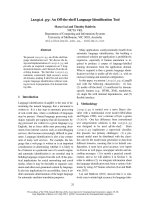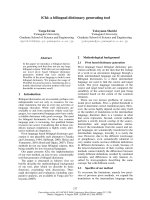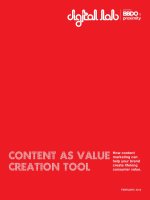Content as Value Creation Tool potx
Bạn đang xem bản rút gọn của tài liệu. Xem và tải ngay bản đầy đủ của tài liệu tại đây (353.87 KB, 21 trang )
content as value
creation tool
How content
marketing can
help your brand
create lifelong
consumer value.
FEBRUARY, 2013
2
EXECUTIVE SUMMARY
Content marketing is all the rage. In a distracted world, where consumers are bombarded
with advertising and overwhelmed by media and device choices, brands are searching for
a new ways to connect—ideally over the long term. And many marketers are turning to
content with varying degrees of success.
What does it mean for a brand to engage in content? What, exactly, is content anyway?
What value is it to brands? Do brands have the right to compete against publishing
companies? How do brands know whether or not their content is driving business results?
This whitepaper will touch on all of these topics. But, if there’s one thing to remember, one
cardinal rule for brands to follow when starting a content marketing program it is this:
Content is often categorized as art or commodity, but for marketers, that misses the point.
First and foremost, it needs to be thought of as a tool for driving discovery, engagement and
trial. And, like all tools it has a purpose—to provide value to the consumer. On that score,
content can always be optimized to provide ever more consumer value, which translates into
ever more brand value.
Written by Craig J. Heimbuch—award-winning journalist and author, best-selling ghostwriter
and Senior Content Strategist at Barefoot Proximity—this whitepaper provides a framework
for brands looking to stand out by creating lasting, even lifelong relationships with
consumers via content.
3
CONTENT marketing
The Path to Lasting Value
All brands seek to connect and bond with consumers. And most brands rely heavily on
advertising to help achieve this. But has there ever been a brand that has bonded deeply
with consumers by just advertising its products’ utility? Has an ad campaign alone ever
done the really hard work to create that special bond? Probably not. Sure, there are those
campaigns that strike a deep chord with people, but in general it’s not the things a brand
says in its advertising that make the difference.
Rather, it’s the qualities the brand embodies through content—which includes but certainly
goes well beyond the bounds of advertising—that create real and lasting value. And the
world we live in makes this both harder and easier to do than ever.
Think about it: We live in an iPhone culture. Access to information is relatively
standardized—TV, radio, podcast, website, social media, print, etc. But the technology
that allows us to be connected makes it easy to create (you might even say )
a unique experience just for yourself. We all have an iPhone—and an iPod, iPad, desktop
4
and laptop—but the chances that the media on any two are exactly the same is pretty slim.
Such media commonality no longer exists. And herein lie challenges and opportunities.
The new content paradigm requires a fresh, consumer-first approach, and content can be
a key asset in developing lifelong consumer relationships in this ever-changing world. This
is particularly so if your content seeks first and foremost to help and inspire consumers and
aims to sell something second. Focus on the former and the odds of the latter happening
rise exponentially.
5
CONTENT AS TOOL
Defining content is both simple and complex. Literally, it’s the words, pictures, videos
or sounds that your user experiences when they come to your platform. That’s the easy
definition. The harder one doesn’t so much describe content, but the opportunity it affords,
which is a more difficult to speak to so succinctly, but necessary to cover.
The content opportunity for marketers begins at a very important intersection where a
person’s desire for specific knowledge, insight and experiences meets a brand’s ability
to serve them up. That service—and it is a service—is rendered through expertise, voice,
format, function and genuine authority, all of which make content valuable.
You have probably heard brands, agencies and media companies talk about content and
noticed some differences between those who create it and those who procure it. The former
views content as art. The latter as a commodity. The former believes they are creating
something of lasting aesthetic value. The latter believes they are buying words in bulk,
much the same way that a company buys paperclips.
Both points of view are sort of right, and sort of wrong. More to the point, they’re both
missing the point.
Digital content can be art or commodity, but it’s better thought of
as a tool. And this tool’s primary purpose is to create value
for the consumer and the brand through a conversion
of some sort, be that from uninterested to
interested, from unregistered to registered, from
no purchase to purchase. As such, with the
right approach regarding performance, the
digital content tool can, like most tools,
be calibrated, refined and optimized
to create more value for both the
consumer and the brand.
Content
IS A TOOL
Depending on host of circumstances, content
may or may not be art. It may or may not be a
commodity. But it most definitely is a tool and
should be thought of that way. Content
is a value creation tool.
6
THE MUTUAL
EXCHANGE OF VALUE
The Internet was created for communication, but it spawned a mass proliferation of choices,
overwhelming most with the range of options. (It is estimated that the amount of information
created from the beginning of civilization to 2003 is now created every three days online.)
The economy has moved from one based on goods and services to something else entirely.
An information economy, which is really an attention economy. And it’s a buyer’s market,
not a seller’s, as is evidenced by the millions of websites, blogs, videos, news outlets and
lifestyle sites all multiplying faster than Tribbles of Star Trek lore. Information of virtually any
and all types is but a Google search, a link or a ‘liked’ item away.
But what if reaching consumers wasn’t just about having a product to sell and trying to
find the right size, placement and creative approach for a banner ad? What if it were about
taking what you know about your consumers—their lives, passions, interests, curiosities
and problems—and serving their needs? What if brands focused on developing lifelong
relationships based on a mutual exchange of value?
Content
IS A CHOICE
Unlike traditional push marketing—TV, radio, print
and online ad campaigns—the effectiveness of
content begins and ends with consumer choice.
In order for content to be impactful, content
needs to be relevant to her life, it needs to
help her, be about her, entertain her or
provide insight into her life.
7
These are the right questions for those intrigued by content marketing to be asking. For
marketers, content is, or at least should be, a service for consumers, not a ploy. Content
wins when it moves beyond the aforementioned metaphor of an intersection to one of a
traffic circle, where a mutual exchange of value between the consumer and the brand spins
in something of an always-fluid, harmonious cycle.
Don’t forget the foundational belief underlying this entire whitepaper: content has, or at
least should have, a ton of value for the consumer, which means that they’re willing to
give something in exchange. It’s worth noting that approximately 60% of all
shared content has a specific brand message in it. Brands clearly
aren’t an impediment to content value. To the contrary.
Consumers derive value from the information,
entertainment and community that a brand
provides through its content. In turn,
brands derive value from consumer
actions, whether those be on
the platform (registering and
providing data), on social
media (championing a
brand) or, of course,
action at the digital or
brick-and-mortar store
shelf (purchase).
Content IS A
CONVERSATION
What you publish is what you say, but like any good
conversation, the most important thing you can do is
listen. A content program needs a solid plan for collecting
and studying analytics and user input. Those learnings
should be used to optimize existing content and influence
future creation. And your analytics strategy should be
mapped to your desired business results. If you want
more sales - and who doesn’t - what consumer actions
can be measured and mapped to your path to purchase?
At Barefoot Proximity, we call this analytical strategy
Content Efficacy.
What if it were about taking what you know about your consumers—
their lives, passions, interests, curiosities and problems
8
Content Marketers
vS Brands as Publishers
Time was, publishing was defined by the person in control of the printing press, the one
who bought ink by the barrel and paper by the forest. It was Guttenberg’s gift to Hearst and
Pulitzer. But Steve Jobs and Bill Gates took it away by putting the printing press in every
pocket, every messenger bag and on every desktop in the world. It’s a natural thought for
marketers—afraid of declining shares in the attention economy—to pursue the “Brands as
Publishers” model.
However, few brands truly manage to do this well. One notable exception is American
Express and their highly regarded Food + Wine and Travel + Leisure magazines. But most
brands that pursue a publishing model find it to be beyond their budgets and, frankly, their
abilities, too, without some rather sweeping changes. It also distracts from their primary
business objectives.
This is why the content marketer model is, generally speaking, more inviting and promising
for a broader range of brands. Content marketers, like any other marketers worth their salt,
tie their activities to KPI’s related to the core business. How will starting a company blog or
Content
IS CURRENCY
Content is the best means of getting as close as possible
to consumers by providing non-product value to their
lives. A brand’s expertise in areas beyond the shelf
can provide value beyond product claims. It
is value given to the consumer with the
hope that she will appreciate it—and
pass it on to her friends.
9
Participation
and Optimization
Publishers value exposure, content marketers value participation and conversion. It’s not enough to
know that your content is enlightening users, but encouraging them to take action – sharing,returning,
opting-in and, ultimately, purchasing. This is why optimization for content marketers is so vital. It’s
not enough to press “publish” in your Content Management System. In fact, your only part of the
way through the process when you do push that button. The real work begins by measuring the level
of participation and conversion that piece of content is causing and optimizing against those desired
actions. If the first step is conception and creation, the second step publishing, steps three to five
are related to analysis and optimization.
content marketing platform enhance our database, create deeper consumer engagement or
move more pallets? Those are the questions you should ask at the start. Not whether or not
you should try to compete with the glossy magazines speaking to your key demographic.
Content marketing isn’t about trying to duplicate a traditional publishing experience,
it’s about creating a user experience that engenders trust, that serves a consumer’s need
for information and satisfies her curiosity in such a way that she bonds with your brand.
It’s about having the right information presented in the right way at the right time.
And it’s about creating an experience that encourages discovery and exploration,
which enhances value for her.
10
CONTENT IS NOT A CAMPAIGN
Obviously, relying only on the perfect ad campaign to build this new, sustainable and
mutually beneficial relationship is problematic. Not only are campaigns fickle in terms of
length of duration, but they are designed to pique curiosity, not satisfy it. Once a consumer
has tried a product, or decided not to, then what? What additional value can they gain from
the campaign?
Content is not—and should not—be made subject to such temporary limitations. Content,
the always-on, always-searchable currency of the attention economy creates an always-
on opportunity to move from speech to conversation, from the hard sell to the often more
effective softer sell.
“The moment of truth” for any campaign is often defined by store-shelf decisions, when a
potential consumer becomes a customer. But the moment of truth for content often happens
much earlier—and far away from the store shelf. It happens in the Google search bar, on a
Facebook feed, a Twitter timeline, a Pinterest board or in an e-mail from a friend with a link
embedded.
Content
IS A PROCESS
There’s no such thing as a perfect piece of content. That’s
the whole idea. So long as the consumer relationship can
be strengthened, the ability of content to bolster that
relationship can be improved. It requires always-on
analysis, constant optimization, and diligence in
continuing to find meaningful opportunities
to create value for her.
11
Success in content is not wholly determined by the number of cases you sell—though that
is certainly important—but in the number of consumer needs, questions or curiosities you
identify and deliver against. Take care of the latter and the former will take care of itself—
perhaps even for a lifetime.
12
SUSTAINABILITY NOT VIRALITY
While the desire and wish of every marketer, the virality of content is rarely, if ever, truly
predictable. It is not something that can be planned for with certainty or manufactured with
complete confidence. Virality is more result than strategy. For instance, Judson Laippley had
not even planned on filming his appearance at a university before his “Evolution of Dance”
video skyrocketed him to fame. He was an inspirational comedian, doing just another
college gig. It was students who filmed it and, after the show, asked if he would mind if they
put the video up on YouTube. Half a billion or so views later and the Toledo-based speaker
is still riding that accidental wave. Yet, he’s still asked for his “secrets” of the viral video.
He has none. No one really does.
Virality is as much a content strategy as lightning is an effective means of illuminating
your living room. Smart brands understand this. Smart brands also understand that a
good content strategy is about consistency and service. Search authority—organic search
authority—is derived from many factors, but one of the most important is how recently
and regularly content is published. Good content marketing is marked by consistency.
Can users reliably check the platform and find something new? Or do they find the same
content time and again? Be consistent and aim to provide daily value, rather than going
for the occasional big splash.
13
QUALITY VS QUANTITY
The question that always comes up when brand managers decide to pursue a content
marketing strategy is this: How much content do we need?
There are no hard rules as it relates to content volume. There is no formula that states
X-number of pieces of content published everyday = Y conversion rate. Every content
strategy has to conform to the realities of budget, platform limitations and expectations.
But here are a few guidelines to follow:
• More content is better, provided that the content gets consumed and shared
• A lot of content does not necessarily mean better engagement
• Regularity of publishing is more important than quantity – it’s better to publish one
piece every day than to upload 500 new pieces of content every other month
There is an interesting relationship between quality and quantity when it comes to content
and this relationship may serve as a guiding principle when establishing your content model.
Quality and quantity are both critical factors. You can develop strong audiences and deep
engagement by focusing on one above the other, though ignoring either one
is problematic.
The Huffington Post, for instance, is one
of the internet’s largest and most well-
trafficked sites. Every day thousands of
articles, videos, slideshows and other content
are uploaded by bloggers, media outlets and
all manner of content producers. Every day, the
Huffington Post publishes content of every stripe
for every conceivable consumer. And, as such, it
is able to serve the interests, needs and curiosities
14
of nearly anyone who visits. The Huffington Post creates connection
and value by volume. In order to continue to grow, the site must add
more and more perspectives and voices, inputs and outputs.
From a publisher’s perspective, The Huffington Post is an incredible
success. It reaches millions of screens every month. But is their
high-volume, shotgun approach the right one for content marketers?
Probably not. Content marketers need to create a specific
experience for users in order to drive business results.
In this respect, content marketers have more to learn
from bloggers like Ree Drummond, “The Pioneer Woman.”
Drummond, a Utah-based home, garden and cooking writer has
built a content brand. Her straightforward, tough-yet-artful approach
to serving her audience is proof positive that quality can drive engagement better than quantity, and
that engagement will drive additional reach. Drummond has more than 500,000 engaged, active users
who have connected with her content—because it satisfies their interests and curiosities. Consumers
know what they will get when they visit the Pioneer Woman and, because of that, they visit often. She
doesn’t overwhelm with quantity, but puts a premium on quality and consistency. Her regularity and
focus on quality are as much a part of her content brand has what she’s writing and talking about.
When it comes to the quantity vs. quality argument, brands should not be afraid
to start small. Produce as much content every day as you can, while
maintaining high standards of quality and consistency. Grow from
there. Focus on engagement over traffic volume. That’s
how brand content becomes more valuable to the
audience and the audience engagement becomes
more valuable to the brand.
Ree Drummond, The Pioneer Woman
stand for
something
Have a point of view, a way of viewing the world that
comes through in your content. Show your audience that
you understand what’s important to them. It’s counter-intuitive,
especially for brandmarketers who want to get the widest possible
consumer base, but important. A singular point-of-view does not
always mean a singular voice, a single author or single topic covered.
It’s about having an equity, something readers/viewers/users can identify
with. The mistake is not risking alienation of some users by having a point-
of-view, but of not connecting with any because you don’t.
15
CONTENT DARWINISM
™
If the substance of content is designed to provide value to consumers, the actions taken by
those same consumers is the source of the value derived by brands. It’s sometimes difficult
to quantify the intrinsic value of content to the consumer. That’s because it’s often more
about a feeling, a notion that resonates with, or perhaps even changes, one’s “inner map,”
than an immediate action. Nonetheless, brands still have an opportunity to understand and
maximize the value of content through measurement.
Traffic and page views are the most-often cited units of measurement when it comes to
content. How many people are coming to your platform? How many pages are they looking
at? But, if you are a brand mounting a content marketing initiative, these two metrics alone
don’t give you a clear enough understanding of your efforts’ value.
For instance, let’s say your platform publishes 50 articles in a month. They are written
based on your editorial guidelines, but are of various formats, by various authors working
for various media networks and blogs. Overall, site traffic is pretty strong, but you sense it
could be better.
If you are looking at traffic and page views, you’re able to see which articles are driving the
highest percentage of both. But what does that really tell you? Just that they were read
16
or shared more. These are both positive
things, for sure, but they don’t give you the
best sense of the bigger picture. If you have
established deeper analytical criteria—criteria
that match to desired business results—you
might notice that the most visited, read or
shared article was not, in fact, the most
valuable. Perhaps the twelfth most popular
article leads to a greater proportion of direct
sales and the number eight story was shared
with greater frequency than any of the seven
above it.
So start with your business results. Sales are
obvious, but if the content is part of an eCRM
program, opt-ins, sign-ups and referrals can
be just as valuable. What are the consumer
behaviors that are indicative of these desired
results? Simply reading an article may have
some value, but a consumer sharing that
article with her Facebook friends is an explicit
endorsement of its value. Site visits are good,
but repeat visits are better, and opt-ins are
better still. Site exits generally aren’t good,
but they sure can be when a consumer is
exiting your site to visit your brand’s social
platform or an e-commerce venue.
In short, brands should also have a clear idea
of the behaviors they hope the content will
inspire—and a means of measuring those
behaviors.
While serving as editor-in-chief of digital
platform, our search and optimization team
believed we had an opportunity to do well
with a story on the topic of maintaining a
career during tough economic times, So I
assigned a story titled “10 Ways to Keep Your
Job in a Down Economy,” and published it
high expectations.
I was frustrated by the lackluster results.
Looking for an answer, we turned to the data.
It showed that, on our site, negatively worded
headlines earned a greater percentage of
organic click-through than positively worded
ones. So, we changed the headline to “10
Ways to Not Lose Your Job in a Down
Economy.” We saw an instant, though
incremental, gain in search traffic.
Still not satisfied, we studied the data even
harder and found that odd-numbered lists
had a higher percentage of click-through
than even-numbered ones (perhaps because
odd-numbered lists seem more authoritative
and less formulaic). So we added a ‘way’
and changed the headline once again to
“11 Ways to Not Lose Your Job in a Down
Economy.” This tweaking resulted in traffic
well beyond our initial expectations for the
piece.
The lessons here are clear: Getting the most
out of your content means vigilance beyond
publishing a piece and simply hoping for the
best. And a lock-step relationship between
your editorial team and your analytics team
will definitely pay dividends.
DARWINISM
IN ACTION
17
We, at Barefoot Proximity, call this Content Darwinism. It’s based on the idea that the
content that works the hardest to drive specific results—the content with the greatest
efficacy—should influence other content decisions and planning. A survival of the fittest
mentality, ensures that your platform’s content is always evolving, always improving. By
mapping micro (pageviews) and macro (opt-in, social following, etc ) conversions affiliated
with each step along the path to purchase to individual pieces of content, we are able,
thanks to our handy-dandy algorithm, to understand the business value of different
pieces of content to the brands we serve.
For example, we can understand what content on a site is working the hardest to drive
discovery, engagement and closing conversions and optimize not only our content mix,
but the consumer journey on the content path to purchase. Perhaps even more importantly,
we can see what content is not working or is hurting conversion and remove it. And the only
way we can do this is by matching the value of content to the business value for the brand.
problem. But then the Panda update was
released.
As a result, content farm articles dropped
precipitously in Google’s search ranks. (One
content farm saw its downstream traffic
decline 40% within a month and a half of the
Panda update.) The content farms’ output
became less valuable to the consumer (it
was harder to find) and less valuable to the
brand (it wasn’t pulling consumers to their
platforms).
The lesson? Good content is not just about
proper syntax and grammar. Good content
on the web is that which has the best chance
of being found, admired and shared, and this
requires some degree of originality versus
an avalanche of the same old content found
in countless other places. Being vigilant in
understanding search trends in the content
marketplace is not only important, but
also vital to protecting the health of your
investment in content.
If constant maintenance and optimization
of your content sounds like an expensive
hassle, consider the costs of not being
awake at the switch. In April 2011, Google
released its Panda update, which, among
other things, sought to curtail the authority
given to content, created by “content farms.”
These are broad networks of loosely affiliated
content creators who sold inexpensive
content to brands and publishers.
Their content was inexpensive because
it was being duplicated on sites across
the internet. Again, this seemed to those
purchasing and selling this duplicative
content like a low-cost solution to a content
A Lesson in
Vigilance:
The Panda Update
18
The content Sourcing
Conundrum
If you are responsible for developing your brand or scale content marketing program,
chances are pretty good that you’ve been on calls with publishers, media networks and
platforms, all of which promise that they’ll make the whole content puzzle a no-brainer
for you. Sit back and relax, they’ll tell you, they’ll take care of it all. But can they really?
And how do you know?
A traditional publisher may boast 12 million page views a month. So might a digital media
network and a content creator network. And they may all be telling the truth. What they may
not reveal is that those millions of page views take very different shapes and forms. The
traditional publisher may be getting those page views across a couple hundred magazine
sites around the world. The digital media network may have 5,000 sites in North America
alone in its ranks. And the content creator network may be getting page views on its content
distributed across hundreds, or even thousands, of sites.
How do you, as the brand’s content manager, know which will provide the best solution for
your platform? The simple answer is: You don’t. And there are problems with trying to apply
publishing, media and network measures of success to a content marketing program. Chief
among those problems is that simply having page views on other platforms does not ensure
success on yours.
Optimize
Everything
A data-centric approach to content goes beyond knowing
what content is resonating with consumers. Your content
analytics plan should include device and time-of-day
insights to help answer key questionsabout what
content is making an impact, when and on what
screen? Optimization is an on-going
process, not an end-state.
19
Brands have a unique opportunity to level the playing field—between content types, content
vendors and content creators—by redefining the value of content. No longer do content
marketing results need to be compared on publishers’ terms (traffic and page views, mostly).
Success in content marketing can now be determined by the success of the content in
driving business results —sales, opt-ins, renewals, trials…whatever your business seeks
to achieve. And when the brand determines the measurement criteria, then the content
formats, creators and vendors all compete to deliver results for the brand based upon
tangible actions taken by consumers.
If content efficacy on a brand platform is defined as content’s ability to achieve business
goals, the Content Darwinism model affords marketers the opportunity to create competition
among partners to see who can create the most value. In the lush and varied world of
content, only the fittest will survive. More to the point, only the fittest should survive.
7
Things to Take Away
1. Use your understanding of her problems, her concerns, her interests and curiosities to guide your strategy. Look
for potential intersections and seek to provide her value beyond your product offering.
2. Learn from her actions what content is most valuable to her and optimize toward creating yet more value.
3. Turn that intersection of her needs and your offering into a virtuous, harmonious circle of mutual appreciation.
4. Set the terms of value without falling subject to those dictated by publishers and media networks with different
measurements of success.
5. Focus on creating a unique experience for the user, not on replicating (poorly done) ones she can get elsewhere.
6. Remember that content creation and evaluation is a process that can always be improved.
7. Target consistency, and don’t get sidetracked by virality.
20
LESSONS LEARNED
Content marketing is not a fad. It’s a way for brands to create lasting, even lifelong,
relationships with consumers based upon the mutual exchange of value. It’s here for good.
And it’s only getting more popular. In research done in August 2012, content thought
leaders Outbrain and Econsultancy found that 92% of in-house brand marketers and 71%
of agencies and consultants already have or are planning a content marketing program.
But, like a lot of big opportunities, success will be had by those who embrace the
challenge and experiment without losing sight of what’s most important, namely the
relationship you must build and nurture with consumers.
In an age when content is the currency of the attention economy, some things have not
changed. The brands people will find the most valuable are the ones that help them make
better sense of their worlds and find more enjoyment within them.
About the Author
CRAIG HEIMBUCH is the Senior Content Strategist at Barefoot Proximity.
An award-winning journalist and author and best-selling ghostwriter, he
leads content strategy for large-scale eCRM programs around the world.
Contact Craig
o: 513.618.0635
m: 513.545.0366
@cheimbuch
facebook.com/craig.heimbuch
craigheimbuch.com
21
WRITTEN BY
CRAIG HEIMBUCH
WWW.BBDO.COM
WWW.PROXIMITYWORLD.COM
WWW.DIGITALLABBLOG.COM
